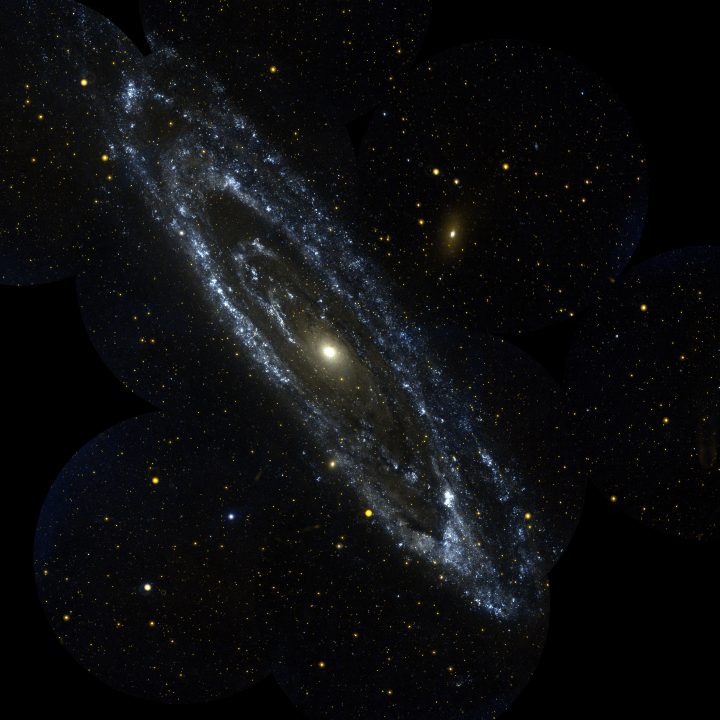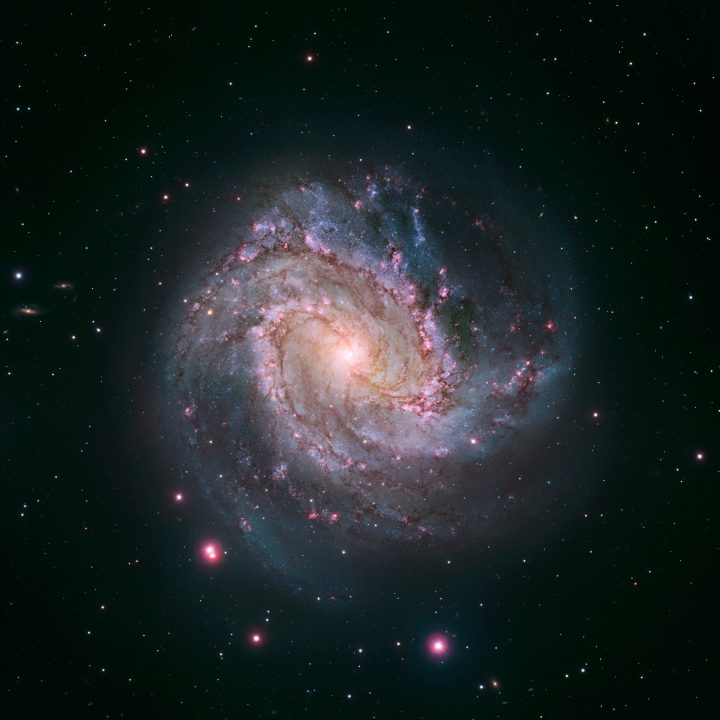Education Hub

For a long time, scientists have wondered what the universe is made of, and up until the discovery of what we now call ‘dark matter’, it seemed that physicists had everything figured out. Through observing the way galaxies spin, however, scientists realized that there wasn’t enough matter in them to keep them from flying apart: essentially, there was ‘missing mass’ that couldn’t be accounted for considering only visible matter (stars, galaxies, dust, etc.).
Click here to try and find dark matter with this interactive game!
How is dark matter different from regular matter? What even IS regular matter? Let’s explore these questions through the following quick activity. However you are reading this webpage, get up and find 4-5 different objects. If possible, find one that you can smell, one that you can eat, and then two or three made out of different materials like metal, plastic, fabric, etc. Consider: What if you chose air as one of your objects?
Once you’ve gathered your items, use your senses to explore them. Make a list of things that all the items have in common, and what makes them different.

Your next step is to take a piece of paper from your recycling bin and tear it in half. Now you have two pieces. Take one of the halves and tear it in two again. If you kept tearing the paper in half over and over, how many times could you do it? Try and tear the paper into the smallest piece you possibly can. How big is it? If you had special tools, could you keep making it smaller? At what point do you think it could be split no further?
One thing that all of the objects you found and used for the activity have in common is that they are all made of the same stuff; matter! So, what is matter then? Well, if you could zoom really far into each of your objects, you would see atoms. Atoms make up everything we can see and experience with our senses on the planet AND in outer space! Atoms are made of three types of particles; protons, neutrons, and electrons. We’ve detected other kinds of particles too, like neutrinos!
But what if there was an invisible kind of matter that we couldn’t see or experience… at all? It turns out there is such a matter; this is where dark matter comes in!

Vera Rubin’s work on the speeds of stars in galaxies was one of the first observation of dark matter and, although it has yet to be detected directly, scientists have confirmed it exists through additional observational data – measuring the way it affects other objects in the universe. Now thought to make up over 85% of mass in the universe, dark matter got its name because it doesn’t interact with or emit in the electromagnetic spectrum (all types of light and radiation we can detect and observe). We have so far only learned about it based on how its gravity affects the universe, so most of our usual observation tools don’t work for dark matter. As a result, one of the major focuses of astroparticle physics, and of the work being done by McDonald Institute researchers, is directly detecting dark matter.
Click here to create a galaxy rotation curve and see what the scientists used as evidence of dark matter!
Learn more about the dark matter experiments McDonald Institute researchers are working on.
PICO
The PICO collaboration uses bubble chamber technology to detect dark matter particles. The ‘bubble chamber’ holds superheated liquid that boils if enough energy is deposited in it, creating bubbles when certain particles interact inside. The sound the bubbles make as they are formed gives scientists clues about the type of particle that created them.
- PICO-40L: Redesigning the bubble chamber technology used in previous iterations, PICO-40L aims to improve background suppression in the search for dark matter. This detector began construction at SNOLAB in 2019 and was completed in 2020. Its two concentric quartz jars eliminate the need for a buffer fluid and features more stringent control over operating conditions.
- PICO-500: PICO-500 is the next generation detector that builds upon the principle demonstrated by previous and current PICO experiments. This larger detector will have an active volume of about 250 litres and will use a synthetic quartz vessel, just like PICO-40L. The PICO collaboration is currently working on the final design of PICO-500, focusing on the inner vessel and the pressure vessel.
SuperCDMS SNOLAB
The Cryogenic Dark Matter Search (CDMS) is attempting to find dark matter particles using silicon and germanium crystals cooled to almost absolute zero. Scientists predict that when a dark matter particle interacts with the crystals, it will cause the crystals to vibrate. The nature of the vibration would provide information about the particle that caused it. SuperCDMS SNOLAB, one of the most sensitive dark matter detectors in the world, is looking for light dark matter.
CUTE
The Cryogenic Underground TEsting facility (CUTE), located at SNOLAB, tests components of upcoming dark matter experiments. CUTE is a dilution refrigerator with water, lead, and polyethelene background radiation shielding that operates at low temperatures and prevents micro-vibrations. CUTE is currently testing the SuperCDMS detector towers.
DEAP-3600
The DEAP-3600 experiment is currently running at SNOLAB and uses a liquid noble gas to detect dark matter. It is a large acrylic sphere filled with 3.6 tonnes of liquid argon kept close to -180 degrees Celsius and surrounded by light detectors. If a particle enters the sphere, it should interact with the liquid argon, producing ultraviolet light that the light detectors would pick up. If enough of the detectors record the light, the interaction is recorded and reviewed so scientists can determine if it was a dark matter particle.
DARKSIDE-20k
A follow-up to the DEAP-3600 detector, DARKSIDE-20k is a multi-hundred tonne argon project at the beginning of development. The detector is based on a dual-phase time projection chamber (TPC) hosted in a cyrostat like the one developed for ProtoDUNE, the prototype for the DUNE neutrino experiment. It’s WIMP-nucleon scattering sensitivity is designed to be near that set by fundamental backgrounds from atmospheric neutrinos.
NEWS-G
New Experiments with Spheres-Gas (NEWS-G) is a new technology being developed to detect dark matter particles. It uses a copper sphere filled with a noble gas, which will be ionised when a dark matter particle passes through. A probe at the centre of the sphere will measure characteristics of the ion to determine if it is a dark matter particle. Prototypes were tested in an underground laboratory in France, and the final version of the experiment was installed at SNOLAB in late 2020.
SBC
The Scintillating Bubble Chamber (SBC) is an upcoming experiment at SNOLAB. The SBC builds on the work and findings of the PICO collaboration for xenon bubble chambers. It is designed to have the strong electron recoil discrimination of a bubble chamber and the scintillation-based energy reconstruction of a noble liquid. Combining these two factors should result in increased sensitivity to low-mass dark matter.
